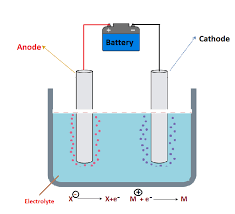anode
Anode (ἄνοδος (anodos), "exit") is an electrode that removes negative particles of electric charge from space.
Which of the electrodes of a specific component represents the anode at a given moment and which the cathode depends on the component type and operating mode. In electrochemistry, the anode represents the electrode on which oxidation takes place. If a sufficiently large external voltage is applied to the electrodes, electrolysis occurs, in which the anode is the electrode with a positive charge. An example is charging a battery. On the contrary, when discharging an electrochemical source, when the current flows in the opposite direction than during charging, the anode is an electrode with a negative charge.
In electronics, this name can be found in components such as a diode or a tube, where the anode is usually (but not always) the electrode with a positive voltage. In semiconductor diodes, the anode is a P-type semiconductor and is connected to a positive voltage in the forward direction. A photodiode is a special case. It is a diode that works as a source of electrical energy when illuminated. In this case, the P-type semiconductor is the positive pole of the source, the current exits from it, passes through the electrical circuit and enters the negative terminal - the N-type semiconductor, which forms the anode.

